Unitron Hearing UWNB1 Hearing aid instruments User Manual UserGuide
Unitron Hearing, Inc. Hearing aid instruments UserGuide
Contents
- 1. UserGuide.pdf
- 2. UserGuide2.pdf
UserGuide.pdf
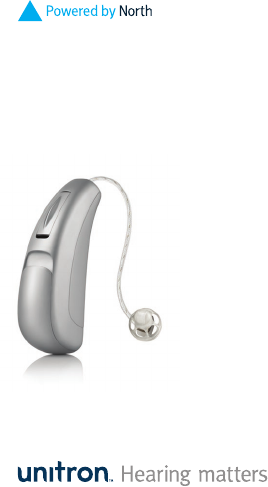
Moxi Dura
behind-the-ear (BTE)
hearing aid guide

Thank you
Thank you for choosing Unitron hearing aids.
At Unitron, we care deeply about people with
hearing loss. We work closely with hearing
healthcare professionals to make advanced,
purpose-driven solutions available to everyone.
Because hearing matters.
This user guide applies to the following models:
N Moxi™ Dura Pro
N Moxi™ Dura
N Moxi™ Dura
N Moxi™ Dura
N Moxi™ Dura
Your hearing aids
Hearing healthcare professional: _______________
___________________________________________
Telephone: _________________________________
Model: ____________________________________
Serial number: ______________________________
Replacement batteries: Size 13
Warranty: __________________________________
Program 1 is for: ____________________________
Program 2 is for: ____________________________
Program 3 is for: ____________________________
Program 4 is for: ____________________________
Date of purchase: ____________________________
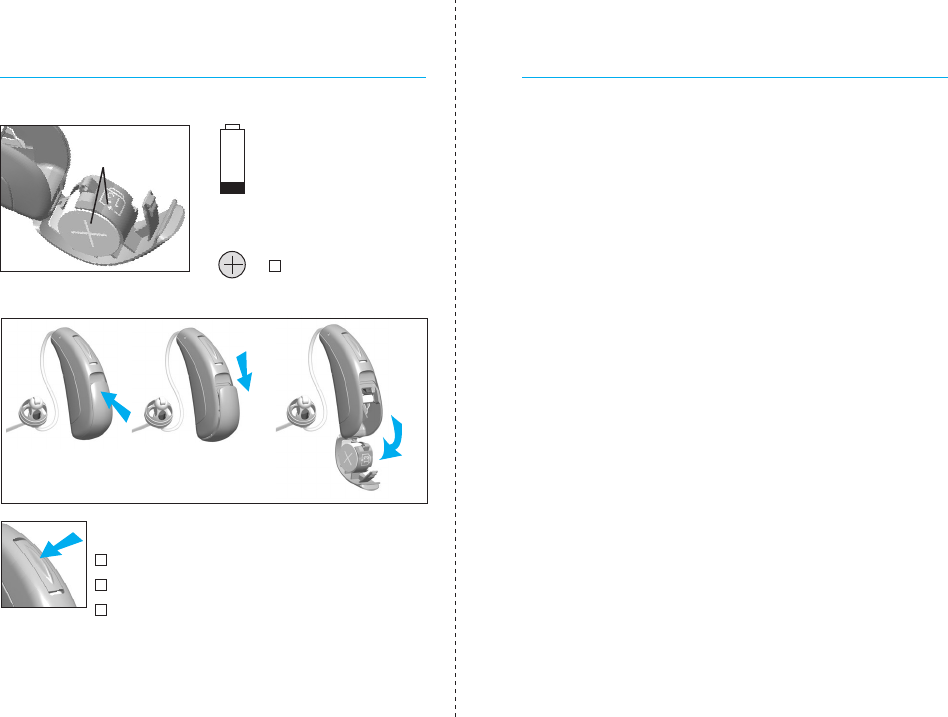
Quick reference
Changing batteries Low battery warning
2 beeps every
30 minutes
13
Table of contents
Your hearing aids at a glance ..................................................... 2
Warnings .................................................................................... 4
Putting your hearing aids on your ears....................................... 9
Turning your hearing aids on and o ........................................ 11
Battery information ...................................................................12
Tips for wearing hearing aids for the rst time ..........................15
Tinnitus masker ........................................................................17
Operating instructions ............................................................. 20
Using the telephone ................................................................. 24
Protecting your hearing aids .................................................... 27
Cleaning your hearing aids .......................................................28
Signature features of your hearingaids ................................... 30
Assistive listening devices ........................................................31
Troubleshooting guide ............................................................. 32
Warning to hearing aid dispensers (tocomplywith the U.S.
Food and Drug Administration (FDA) regulations) .................. 37
Information and explanation of symbols ................................. 40
Compliance information ........................................................... 42
Patient feedback ...................................................................... 44
Additional notes ....................................................................... 45
Plus (+)
signs
Battery size
On/O
Push button
switching programs
volume control
both: switching programs with right ear
and volume control with le ear
On O Open
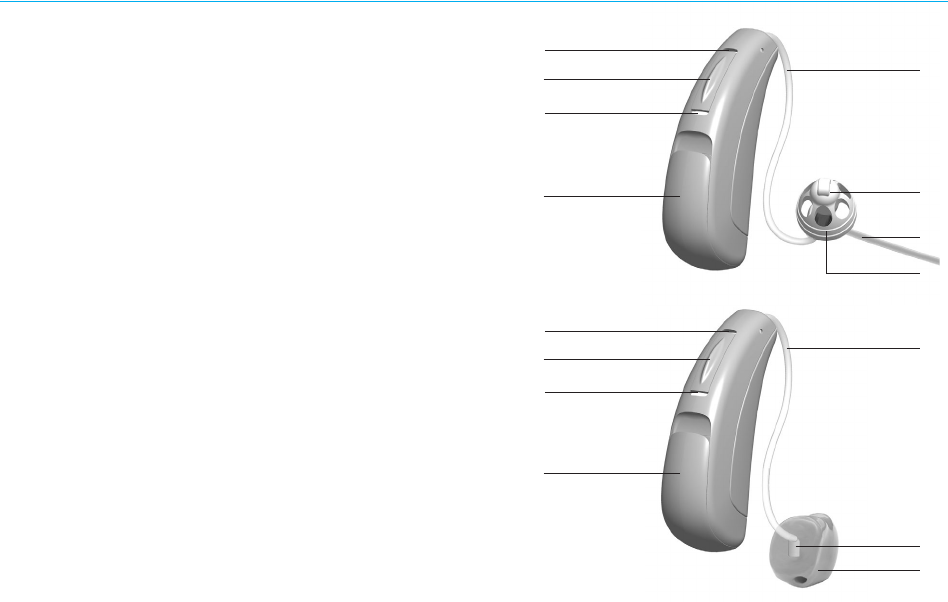
2 3
Your hearing aids at a glance
1 Wire - connects the speaker unit to your
hearingaids
2 Microphone - sound enters your hearing aids
through the microphones. An inner microphone
shield protects the microphones from dirt and
debris
3 Push button - switches between listening
programs or changes the volume level,
depending on your customized tting
4 Battery door (on & o) - close the door to turn on
your hearing aids, partly open the door to turn
o your hearing aids. Opening the door all the
way gives you access to change the battery
5 Dome - holds the wire in place in your ear canal
6 Retention piece - helps prevent the dome and
wire from moving out of the ear canal
7 Speaker unit - amplies the sound and sends it
directly into the ear canal
8 Custom mold - holds the hearing aids in place
and contains the speaker unit
2
2
2
2
3
3
4
4
5
1
6
8
7
7
1

4 5
Warnings
The intended use of hearing aids is to
amplify and transmit sound to the ears and
hereby compensate for impaired hearing.
The hearing aids (specially programmed for
each hearing loss) must only be used by the
intended person. They should not be used
by any other person as they could damage
hearing.
Hearing aids should only be used as
directed by your physician or hearing
healthcare professional.
Hearing aids will not restore normal
hearing and will not prevent or improve a
hearing impairment resulting from organic
conditions.
Do not use your hearing aids in explosion
hazard areas.
Allergic reactions to hearing aids are unlikely.
However, if you experience itching, redness,
soreness, inflammation or a burning
sensation in or around your ears, inform
your hearing healthcare professional and
contact your physician.
In the unlikely case that any parts remain
in the ear canal aer the removal of the
hearing aid, contact a physician immediately.
Remove your hearing aids for CT and
MRI scans or for other electromagnetic
procedures.
Special care should be exercised in wearing
hearing aids when maximum sound
pressure levels exceed 132 decibels. There
may be a risk of impairing your remaining
hearing. Speak with your hearing healthcare
professional to ensure the maximum output
of your hearing aids is suitable for your
particular hearing loss.
Magnet warnings
Be sure the magnet is securely axed to the
telephone.
Keep loose magnets out of reach of children
and pets.

6 7
Precautions
The use of hearing aids is only part of
hearing rehabilitation; auditory training and
lip reading instruction may be required as
well.
In most cases, infrequent use of hearing
aids does not provide full benet. Once you
have become accustomed to your hearing
aids, wear your hearing aids everyday all
day.
Your hearing aids use the most modern
components to provide the best possible
sound quality in every listening situation.
However, communication devices such as
digital cell phones can create interference
(a buzzing sound) in hearing aids. If you
experience interference from a cell phone
being used close by, you can minimize this
interference in a number of ways. Switch
your hearing aids to another program, turn
your head in a dierent direction or locate
the cell phone and move away from it.
If the magnet falls into your ear, contact your
hearing healthcare professional.
If the magnet is swallowed, contact your
physician immediately.
The magnet may aect some medical
devices or electronic systems. Always keep
the magnet (or the telephone equipped with
the magnet) at least 30 cm (12”) away from
pacemakers, credit cards, floppy disks or
other magnetically sensitive devices.
Too high distortion during dialing or
phoning may mean that the phone handset
is stressed by the magnet. To avoid any
damage, please move the magnet to
another place on the telephone receiver.
Battery warnings
Never leave hearing aids or batteries where
small children and pets can reach them.
Never put hearing aids or batteries in
your mouth. If a hearing aid or battery is
swallowed, call a physician immediately.
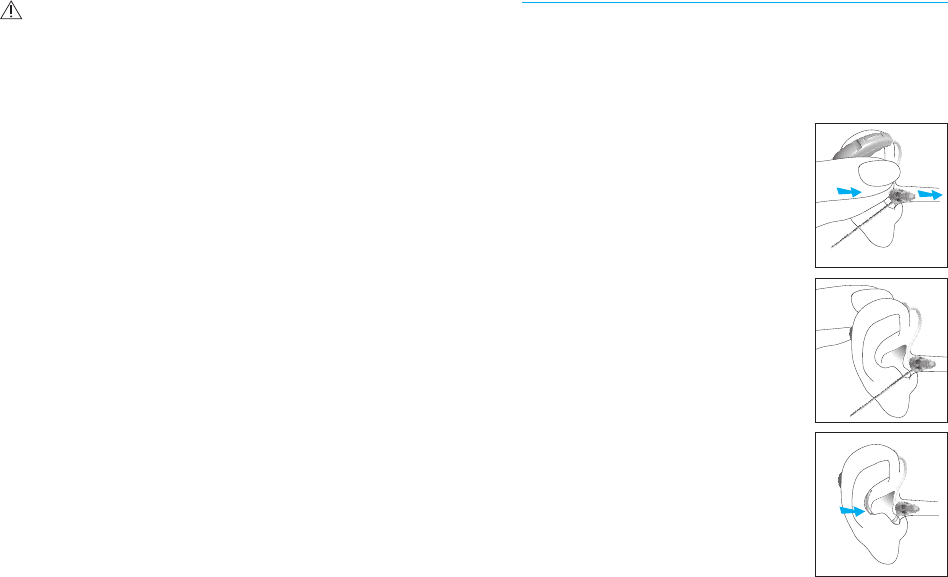
8 9
Putting your hearing aids on your ears
Your hearing aids may be color-coded with a
small dot that is visible when the battery door is
open: red = right ear; blue = le ear.
Hearing aids with domes
1. Hold the wire where it
attaches to the dome and
gently push the dome into
your ear canal. The wire
should lie flush against your
head and not stick out.
2. Place the hearing aid over
the top of your ear.
3. Place the retention piece
in your ear so it rests at the
bottom of the opening of
your ear canal.
1.
2.
3.
Note to hearing healthcare professional
Domes should never be tted on patients
with perforated eardrums, exposed middle
ear cavities, or surgically altered ear
canals. In the case of such a condition, we
recommend to use a customized ear mold.
Labeling
The serial number and year of manufacture are
located inside the battery door.
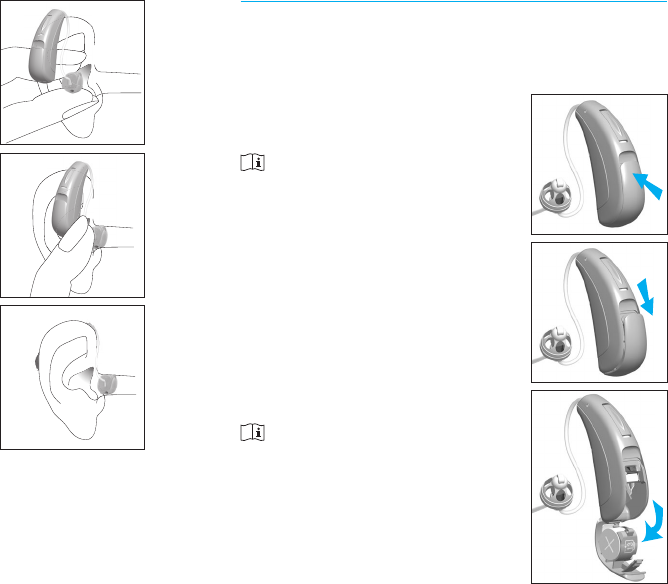
10 11
Hearing aids with custom shells
1. Hold the custom shell
between your thumb and
index nger. The opening
should be pointing in
towards your ear canal
with the hearing aid
resting above your ear.
2. Carefully insert the
custom shell into your
ear. The shell should t
into your ear snugly and
comfortably.
3. Place the hearing aid over
the top of your ear.
1.
2.
3.
Turning your hearing aids on and o
Your hearing aids have a three-position battery
door that acts as an on/o switch and that
allows access to the battery compartment.
1. On: Close the battery door
fully.
Note: It may take ve seconds
before the hearing aid turns
on. Your hearing healthcare
professional can increase the
start up delay if required.
2. O: Partially open the
battery door.
3. Open: Fully open the battery
door to access and change
the battery.
Note: When turning your
hearing aid on and o while it
is on the ear, grasp the top and
bottom of the hearing aid with
your index nger and thumb.
Use the index nger of your
opposite hand to open and
close the battery door.
1.
1.
2.
3.
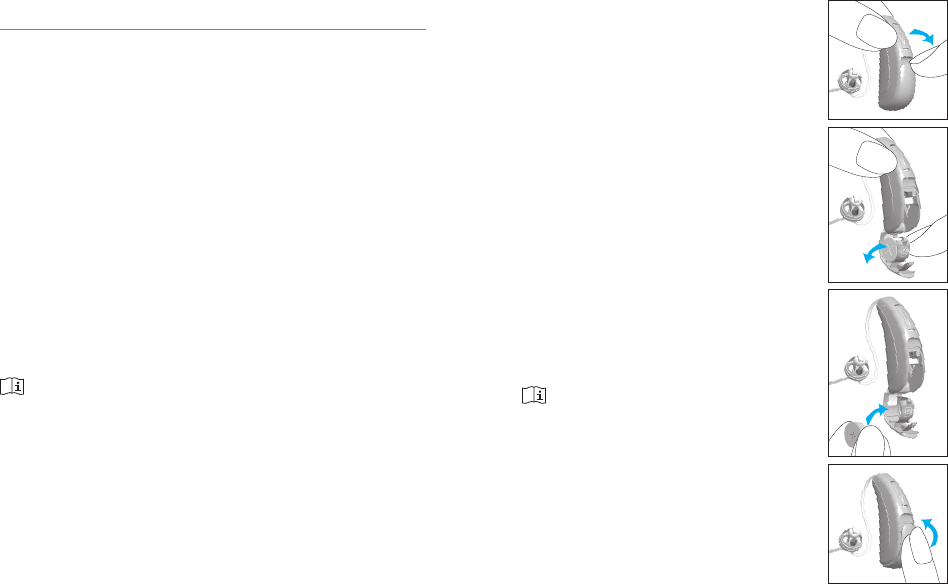
12 13
Battery information
To replace the battery, fully open the battery
door for access to the battery compartment.
Low battery warning
Two long beeps indicate the hearing aid battery
is low. Aer the low battery warning, sounds
may not be as clear. This is normal and can be
xed by changing the batteries in the hearing
aids.
If you are not able to hear the low battery
warning, your hearing healthcare professional
can change its pitch or loudness. If you prefer, it
can be turned o entirely.
Your hearing aids are designed to generate a
low battery warning every 30 minutes until you
change the batteries, but depending on the
condition of the batteries, they may die before
another low battery warning occurs. Therefore,
it is recommended that the batteries are
replaced as soon as possible once you hear the
low battery warning.
Replacing the battery
1. Gently swing out the battery
door with your ngernail.
2. Grasp the battery with your
thumb and index nger and
remove.
3. Insert the new battery into the
battery compartment with the
plus (+) sign on the battery
facing the same way as the
plus (+) sign on the edge of
the battery door. This will
ensure that the battery door
closes properly.
Note: If the battery is inserted
incorrectly, the hearing aid will
not turn on.
4. Close the battery door.
1.
2.
3.
4.

14 15
Caring for batteries
Always discard batteries in a safe and
environmentally friendly way.
To prolong battery life, remember to turn your
hearing aids o when not in use, especially
when asleep.
Remove the batteries and keep the battery door
open while hearing aids are not being worn,
especially when asleep. This will allow internal
moisture to evaporate.
Tips for wearing hearing aids for the
rst time
• Start in a quiet room at home rst to get
used to the new sound quality. Sounds like
the ticking of a clock, the humming of the
computer, the beep of the microwave or the
rustling of clothes or paper may seem loud
to you at rst, because you have not been
hearing them properly for a long time.
• Read aloud to yourself and learn to adjust
the volume of your own voice when you are
wearing the hearing aids.
• Talk to dierent people and learn how to
distinguish between dierent sound patterns
again.
• It will take some time before you are
completely used to your hearing aids and can
fully enjoy the benets.
• Wear your hearing aids for as many hours a
day as you can, and for a little longer each
day.

16 17
• Make notes at the back of this booklet,
write down dicult situations and describe
what any unpleasant noises were like. This
information will help your hearing healthcare
professional to ne-tune the hearing aids
better for your needs.
• Involve your family and friends in this
familiarization period. For example,
ask someone to set the television to a
comfortable volume.
• When you are beginning to get used to
wearing the hearing aids, wear them in more
dicult listening environments such as the
oce, at parties or in restaurants. This can
be dicult even for people who can hear
normally. Give yourself time to regain your
ability to hear in these dicult situations.
• Make your hearing aids part of your everyday
life and be patient with yourself while you are
learning to hear sounds correctly.
Tinnitus masker
Unitron’s tinnitus masker is a broadband
sound generator available on the Unitron North
hearing aid platform. It provides a means of
sound enrichment therapy that can be used as
part of a personalized tinnitus management
program to provide temporary relief from
tinnitus.
The underlying principle of sound enrichment
is to provide supplementary noise stimulation
which can help defocus your attention from
your tinnitus and avoid negative reactions.
Sound enrichment, coupled with instructional
counseling, is an established approach to
managing tinnitus.
Tinnitus masker warnings
Air conduction hearing aids with Unitron’s
tinnitus masker are to be tted by a hearing
healthcare professional familiar with the
diagnosis and management of tinnitus.

18 19
Should you develop any side eects while
using Unitron’s tinnitus masker, you should
discontinue use of the device and seek a
medical evaluation. Side eects include
headaches, nausea, dizziness, heart
palpitations or decrease in auditory function
(such as decreased tolerance to loudness,
speech not as clear or worsening of tinnitus).
The volume of Unitron’s tinnitus masker
can be set to a level which could lead to
permanent hearing damage when used
for a prolonged period of time. Should the
tinnitus masker be set to such a level in
your hearing aid, your hearing healthcare
professional will advise you of the maximum
amount of time per day you should use the
tinnitus masker. The tinnitus masker should
never be used at uncomfortable levels.
Important information
Unitron’s tinnitus masker generates sounds
that are used as part of your personalized
temporary tinnitus management program to
provide relief from tinnitus. It should always
be used as prescribed by a hearing healthcare
professional who is familiar with the diagnosis
and treatment of tinnitus.
Good health practice requires that a person
reporting tinnitus have a medical evaluation by
a licensed ear physician before using a sound
generator. The purpose of such an evaluation
is to ensure that medically treatable conditions,
which may be causing tinnitus, are identied
and treated prior to using a sound generator.
Unitron’s tinnitus masker is intended for adults
18 years of age or older who have both hearing
loss and tinnitus.
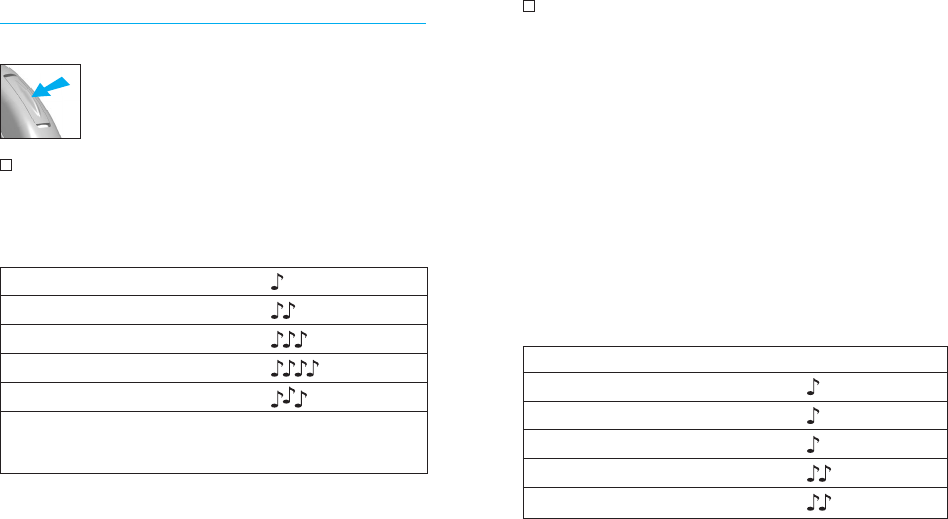
20 21
Operating instructions
Push button
Your hearing aids come with a push
button that allows you to further
adjust them.
Program control
If you have an active push button program
control, each time you push the button, you will
move to a new hearing aid program.
Program 1 (e.g. automatic program) 1 beep
Program 2 (e.g. speech in noise) 2 beeps
Program 3 (e.g. easy-t/telephone) 3 beeps
Program 4 (e.g. music) 4 beeps
Easy-t/telephone (see pg 25) short melody
DuoLink (if enabled) (see pg 23) Opposite ear beeps
the same as side
being adjusted
Your hearing aids beep to indicate which
program you are in.
Please see the front of this booklet for a listing
of your personalized programs.
Volume control
If your push button has been congured as a
volume control, either:
• Push the button on your right hearing aid to
increase the volume in both hearing aids
• Push the button on your le hearing aid to
decrease the volume in both hearing aids
or:
• Push the button to step through your volume
options
As you change the volume control, your hearing
aids will beep.
Volume setting Beeps
Suggested volume level 1 beep
Turning volume up short beep
Turning volume down short beep
Maximum volume level 2 beeps
Minimum volume level 2 beeps

22 23
Both program and volume control
• Push the button on your right hearing aid to
access your dierent programs
• Push the button on your le hearing aid to
step through your volume options
Tinnitus masker
If your hearing healthcare professional has
congured both a tinnitus masker program and
a volume control, you can adjust the tinnitus
masker level while you are in the tinnitus
masker program. To adjust the noise level,
either:
• Push the button on your right hearing aid to
increase the tinnitus masker in both hearing
aids
• Push the button on your le hearing aid to
decrease the tinnitus masker in both hearing
aids
or:
• Push the button to step through your tinnitus
masker options
As you change the level, your hearing aids will
beep.
For more information or details, please see
page 17.
DuoLink
If DuoLink is enabled, then changing the
volume or program settings on one hearing
aid will automatically make the change to both
hearing aids at the same time.
For example, if your push button is congured
as a program control and DuoLink is enabled,
when you push the button on your right hearing
aid, the program will change on both hearing
aids.
Remote control
Your hearing aids may also come with an
optional remote control which allows you to
switch between dierent listening programs
and change your volume settings.

24 25
Using the telephone
As telephones do not all work the same, you
may experience dierent results from dierent
phones. You can use many phones by simply
holding the receiver to your ear, without the
need to change to a dedicated telephone
program on your hearing aid. You may need to
move the handset slightly up or back to nd the
position that sounds best to you.
Depending on the phone type you use, your
hearing healthcare professional might have
selected a dedicated phone program on your
hearing aids. Your hearing aids may have an
automatic telephone program (easy-t feature),
which automatically switches to a dedicated
telephone program when a telephone receiver
is brought close to one of your hearing aids. You
will hear a short melody to indicate you are in
the telephone (easy-t) program.
When the receiver is moved away from the
hearing aid, it will automatically return to the
previous listening program. If the hearing aid
does not switch to the telephone program
1.
2.
3.
automatically when the telephone receiver is
held to the ear, the magnet for easy-t hearing
aids should be attached to the telephone
receiver. The magnet is designed to strengthen
the magnetic eld at the ear piece of hearing
aid compatible telephones.
To ax the optional magnet:
1. Clean the telephone receiver.
Hold the magnet near
the “listening end” of your
telephone receiver and release
it. The magnet will flip to the
appropriate side and seek
the optimal position on the
telephone receiver.
2. Place the double-sided tape
in this optimal position on the
telephone receiver.
3. Attach the magnet to the tape.

26 27
Your hearing healthcare professional may
also have set up a phone program that you
can access through the push button on your
hearing aids, or through your optional remote
control.
If your hearing aids are congured to work with
the wireless uDirect™ or uStream streamers,
you might benet from a Bluetooth® hands free
option. Refer to the uDirect or uStream user
guide for more information.
The Binaural Phone feature enables you to hold
a phone to one ear and hear the sound clearly
in both ears. No accessories are required.
Protecting your hearing aids
• Open the battery door when not in use.
• Always remove your hearing aids when
using hair care products. The hearing aids
can become clogged and cease to function
properly.
• Do not wear your hearing aids in the bath or
shower or immerse them in water.
• If your hearing aids do become wet, do not
attempt to dry them in an oven or microwave.
Do not adjust any controls. Open the battery
doors immediately, and allow your hearing
aids to dry naturally for 24 hours.
• Protect your hearing aids from excessive heat
(hair dryer, vehicle glove box or dashboard).
• Ensure you do not twist or squeeze the tube
when your hearing aids are placed in their case.
• Regular use of a dehumidier, such as a
Dri-Aid kit, can help prevent corrosion and
prolong the life of your hearing aids.
• Do not drop your hearing aids or knock them
against hard surfaces.

28 29
Cleaning your hearing aids
Use a so cloth to clean your hearing aid at the
end of each day, and place it in its case with
the battery door open to allow moisture to
evaporate.
Ear wax is natural and common. Ensuring your
hearing aids are free of ear wax is an important
step in your daily cleaning and maintenance
routine.
Never use alcohol to clean your hearing aids,
custom molds or domes.
Do not use sharp tools to dislodge ear wax.
Sticking household items into your hearing aids
or custom molds can seriously damage them.
Cleaning your custom shells and domes
Clean the domes and shells on
the outside daily with a damp
cloth. Avoid getting any water
in and around the speaker units
(microphone shields) and custom shells.
Note: The wires, speakers, domes or custom
shells should never be rinsed or submerged
in water as water drops may block sound or
damage the electrical components of the
hearing aids.
Domes should be replaced by your hearing
healthcare professional every 3-6 months or
when they become sti, brittle, or discolored.
If your shells require further cleaning, the
speaker waxguard may be plugged and
require replacing. See your hearing healthcare
professional.

30 31
Signature features of your
hearingaids
Binaural Phone
The Binaural Phone feature enables you to hold
a phone to one ear and hear the sound clearly
in both ears. No accessories are required.
uDirect , uStream and uTV
The uDirect , uStream and uTV™ are optional
accessories for your hearing aids.
• uDirect and uStream are streamers that
provide easy, hands-free access to Bluetooth
enabled devices, such as mobile phones.
They can provide remote control functions
to adjust your hearing aids for increased
listening comfort. uDirect also has a wired
audio jack to plug in devices like MP3
players.
• uTV is used with a streamer to send sound
from your TV directly to your hearing aids.
The uTV can also transmit sound from
stereo systems, computers and other audio
sources.
For more information on using the uDirect ,
uStream or uTV, please see the user guide for
that accessory. For information on how to get a
streamer or uTV accessory, please contact your
hearing healthcare professional.
Assistive listening devices
Listening in public places
Telecoils pick up electromagnetic energy and
convert it into sound. Your hearing aid’s telecoil
option can help you listen in public places
equipped with telecoil compatible assistive
listening devices such as a loop system.
Whenyou see this symbol, it means
that there is a loop system installed;
this loop system is compatible with
your hearing aid. Please contact your hearing
healthcare professional for more information on
loop systems.

32 33
Cause Possible remedy
No sound
Not turned on Turn on
Low/dead battery Replace battery
Poor battery contact Consult your hearing
healthcare professional
Battery upside down Insert battery plus (+) side
up
Custom shells/domes
blocked with ear wax
Clean custom shells/
domes. See “Cleaning
your hearing aids.” Consult
your hearing healthcare
professional
Plugged microphone
shield
Consult your hearing
healthcare professional
Troubleshooting guide Cause Possible remedy
Not loud enough
Low volume Turn up volume; see
hearing healthcare
professional for models
without a manual volume
control or if problem
persists
Low battery Replace battery
Custom shells/domes not
inserted properly
See “Putting your hearing
aids on your ears.” Remove
and reinsert carefully
Change in hearing Consult your hearing
healthcare professional
Custom shells/domes
blocked with ear wax
Clean custom shells/
domes. See “Cleaning
your hearing aids.” Consult
your hearing healthcare
professional
Plugged microphone
shield
Consult your hearing
healthcare professional

34 35
Cause Possible remedy
Intermittent
Low battery Replace battery
Dirty battery contact Consult your hearing
healthcare professional
Two long beeps
Low battery Replace battery
Whistling
Custom shells/domes not
inserted properly
See “Putting your hearing
aids on your ears.” Remove
and reinsert carefully
Hand/clothing near ear Move hand/clothing away
from ear
Poorly tting custom
shells/domes
Consult your hearing
healthcare professional
Cause Possible remedy
Not clear, distorted
Poorly tting custom
shells/domes
Consult your hearing
healthcare professional
Custom shells/ domes
blocked with ear wax
Clean custom shells/
domes. See “Cleaning
your hearing aids.” Consult
your hearing healthcare
professional
Low battery Replace battery
Plugged microphone
shield
Consult your hearing
healthcare professional
Custom shells/domes falling out of ear
Poorly tting custom
shells/domes
Consult your hearing
healthcare professional
Custom shells/domes not
inserted properly
See “Putting your hearing
aids on your ears.” Remove
and reinsert carefully

36 37
Cause Possible remedy
Weak on the telephone
Telephone not positioned
properly
Move telephone receiver
around ear for clearer
signal. See “Using the
telephone”
Hearing aid requires
adjustment
Consult your hearing
healthcare professional
For any problems not listed in the guide, contact your
hearing healthcare professional.
Warning to hearing aid dispensers
(tocomplywith the U.S. Food and Drug
Administration (FDA) regulations)
A hearing aid dispenser should advise a prospective hearing aid
user to consult promptly with a licensed physician (preferably
an ear specialist) before dispensing a hearing aid if the hearing
aid dispenser determines through inquiry, actual observation,
or review of any other available information concerning the
prospective user, that the prospective user has any of the
following conditions: (i) Visible congenital or traumatic deformity
of the ear. (ii) History of active drainage from the ear within the
previous 90 days. (iii) History of sudden or rapidly progressive
hearing loss within the previous 90 days. (iv) Acute or chronic
dizziness. (v) Unilateral hearing loss of sudden or recent onset
within the previous 90 days. (vi) Audiometric air-bone gap
equal to or greater than 15 decibels at 500 hertz (Hz), 1,000
Hz, and 2,000 Hz. (vii) Visible evidence of signicant cerumen
accumulation or a foreign body in the ear canal. (viii) Pain
or discomfort in the ear. Special care should be exercised in
selecting and tting a hearing aid whose maximum sound
pressure level exceeds 132 decibels because there may be risk
of impairing the remaining hearing of the hearing aid user. [This
provision is required only for those hearing aids with a maximum
sound pressure capability greater than 132 decibels (dB).]
Important notice for prospective hearing aid users
Good health practice requires that a person with a hearing loss
have a medical evaluation by a licensed physician (preferably
a physician who specializes in diseases of the ear) before
purchasing a hearing aid.

38 39
Licensed physicians who specialize in diseases of the ear
are oen referred to as otolaryngologists, otologists or
otorhinolaryngologists. The purpose of medical evaluation is
to assure that all medically treatable conditions that may aect
hearing are identied and treated before the hearing aid is
purchased. Following the medical evaluation, the physician will
give you a written statement that states that your hearing loss
has been medically evaluated and that you may be considered
a candidate for a hearing aid. The physician will refer you to an
audiologist or a hearing aid dispenser, as appropriate, for a
hearing aid evaluation. The audiologist or hearing aid dispenser
will conduct a hearing aid evaluation to assess your ability to
hear with and without a hearing aid. The hearing aid evaluation
will enable the audiologist or dispenser to select and t a hearing
aid to your individual needs. If you have reservations about your
ability to adapt to amplication, you should inquire about the
availability of a trial-rental or purchase-option program. Many
hearing aid dispensers now oer programs that permit you to
wear a hearing aid for a period of time for a nominal fee aer
which you may decide if you want to purchase the hearing aid.
Federal law restricts the sale of hearing aids to those individuals
who have obtained a medical evaluation from a licensed
physician. Federal law permits a fully informed adult to sign a
waiver statement declining the medical evaluation for religious or
personal beliefs that preclude consultation with a physician. The
exercise of such a waiver is not in your best health interest and its
use is strongly discouraged.
Children with hearing loss
In addition to seeing a physician for a medical evaluation, a
child with a hearing loss should be directed to an audiologist
for evaluation and rehabilitation since hearing loss may cause
problems in language development and the educational and
social growth of a child. An audiologist who is qualied by training
and experience to assist in the evaluation and rehabilitation of a
child with hearing loss is recommended.
Cell phone
Some hearing aid users have reported a buzzing sound in their
hearing aids when they are using cell phones. According to the
ANSI C63.19 standard, the compatibility of a particular hearing
aid and cell phone can be predicted by adding the rating for the
hearing aid immunity to the rating for the cell phone emissions.
The sum of the hearing aid rating (e.g. M2/T2 = 2) and the
telephone rating (e.g. M3/T3 = 3) is 5, and any combination
that equals 5 will provide ‘normal use’. A sum of 6 or greater
indicates ‘excellent performance’. The equipment performance,
measurements, categories and system classications are based
upon the best information available but cannot guarantee that all
users will be satised.
The rating of this hearing aid is at least M2/T2. Your hearing
healthcare professional can provide the actual rating for this
hearing aid.
Note: The performance of the individual hearing aids may
vary with individual cell phones. Therefore, please try the
hearing aid with your cell phone or, if you are purchasing a
new phone, please be sure to try it with your hearing aid prior
to purchase. For additional guidance, please ask your hearing
healthcare professional for the booklet entitled “Hearing aid
compatibility with digital wireless cell phones.”
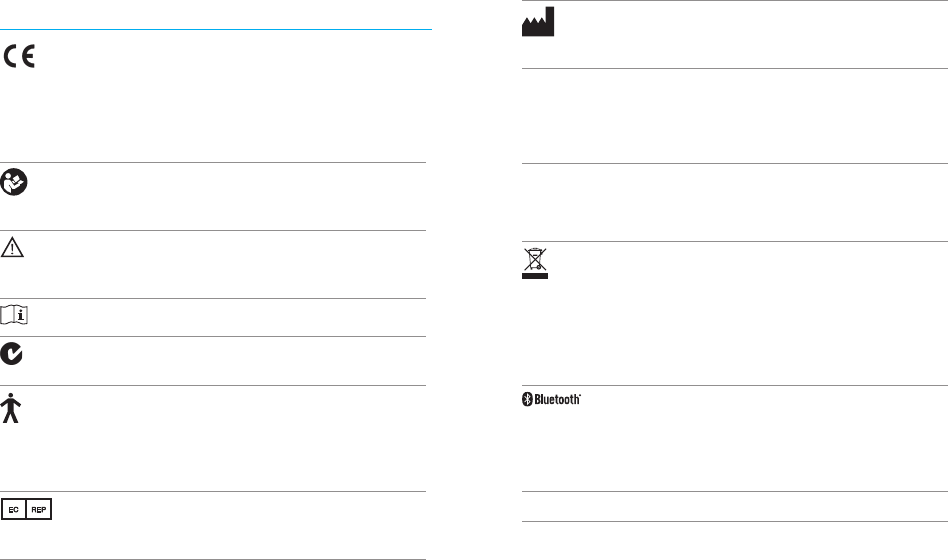
40 41
Information and explanation of symbols
xxxx
The CE symbol is a conrmation by Unitron that this
Unitron product meets the requirements of the R&TTE
Directive 1999/5/EC on Radio and Telecommunication
Terminal Equipment. The numbers aer the CE symbol
are the numbers of the consulted certied bodies
under the above mentioned directives.
This symbol indicates that it is important for the user to
read and take into account the relevant information in
this user guide.
This symbol indicates that it is important for the user
to pay attention to the relevant warning notices in this
user guide.
Important information for handling and product safety.
Australian EMC and Radiocommunications compliance
label.
This symbol indicates that the products described in
these user instructions adhere to the requirements for
an application part of Type B of EN 60601-1. The surface
of the hearing aid is specied as applicated part of
Type B.
This symbol shall be accompanied by the name and
the address of the authorised representative in the
European Community.
This symbol shall be accompanied by the name and
the address of the manufacturer (who are placing this
device on the market).
Operating conditions:
This device is designed such that it functions without problems or
restrictions if used as intended, unless otherwise noted in these
user guides.
Transport and storage conditions:
Temperature: –20° to +60° Celsius (–4° to +140° Fahrenheit).
Humidity: Up to 90% (non condensing).
The symbol with the crossed-out garbage bin is to make
you aware that this device may not be thrown away
as normal household waste. Please dispose of old or
unused devices, at waste disposal sites intended for
electronic waste, or give your device to your hearing
healthcare professional for disposal. Proper disposal
protects the environment and health.
The Bluetooth® word mark and logos are registered
trademarks owned by Bluetooth SIG, Inc. and any
use of such marks by Unitron is under license. Other
trademarks and trade names are those of their
respective owners.
Moxi Moxi is a trademark of Unitron.

42 43
Compliance information
Declaration of conformity
Hereby Unitron declares that this Unitron product meets the
requirements of the Medical Devices Directive 93/42/EEC as
well as the Radio and Telecommunications Terminal Equipment
Directive 1999/5/EC. The full text of the Declaration of Conformity
can be obtained from the manufacturer.
The hearing aid described in this user guide is certied under:
Standard hearing system
USA FCC ID: VMY-UWNB1
Canada IC: 2756A-UWNB1
Notice 1
This device complies with Part 15 of the FCC Rules and with RSS-
210 of Industry Canada. Operation is subject to the following two
conditions:
1) this device may not cause harmful interference, and
2) this device must accept any interference received, including
interference that may cause undesired operation.
Notice 2
Changes or modications made to this device not expressly
approved by Unitron may void the FCC authorization to operate
this device.
Notice 3
This device has been tested and found to comply with the limits
for a Class B digital device, pursuant to Part 15 of the FCC Rules
and ICES-003 of Industry Canada. These limits are designed to
provide reasonable protection against harmful interference in
a residential installation. This device generates, uses and can
radiate radio frequency energy and, if not installed and used in
accordance with the instructions, may cause harmful interference
to radio communications. However, there is no guarantee that
interference will not occur in a particular installation. If this
device does cause harmful interference to radio or television
reception, which can be determined by turning the equipment o
and on, the user is encouraged to try to correct the interference
by one or more of the following measures:
• Reorient or relocate the receiving antenna
• Increase the separation between the equipment and receiver
• Connect the device into an outlet on a circuit dierent from
that to which the receiver is connected
• Consult the dealer or an experienced radio/TV technician for
help
Australia: Supplier Code Number N15398
New Zealand: Supplier Code Number Z1285

Patient feedback
Record your specic needs or concerns and bring to
your rst oce visit aer getting your hearing aids.
This will help your hearing healthcare professional
to address your needs.
________________________________________
________________________________________
________________________________________
________________________________________
________________________________________
________________________________________
________________________________________
________________________________________
________________________________________
________________________________________
Additional notes
___________________________________________
___________________________________________
___________________________________________
___________________________________________
___________________________________________
___________________________________________
___________________________________________
___________________________________________
___________________________________________
___________________________________________
___________________________________________
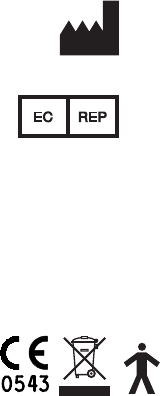
46
Unitron Hearing
20 Beasley Drive, P.O. Box 9017,
Kitchener, ON N2G 4X1 Canada
Unitron Hearing GmbH
Max-Eyth-Straße 20, 70736
Fellbach-Oengen, Germany
For a listing of Unitron group
companies, please visit
www.unitron.com

Distributor
unitron.com
14-061 029-6013-02
7
630034 302233